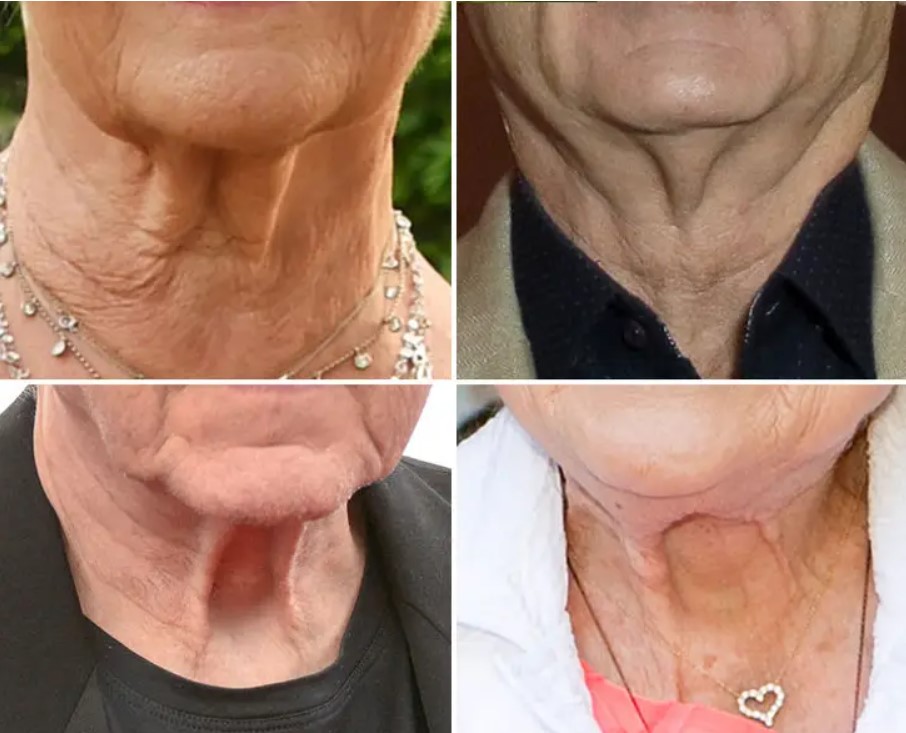Introduction
Turkey neck? It’s not just for Thanksgiving, unfortunately. Dealing with sagging skin on the neck, often referred to as “turkey neck,” can be a frustrating and confidence-knocking experience. However, fear not, as there are various ways to combat and get rid of this pesky problem. In this comprehensive guide, we’ll explore the causes of turkey neck, prevention strategies, exercises, treatments, procedures, lifestyle changes, and more to help you say goodbye to turkey neck for good. Turkey neck – how to get rid of this hell? Let’s dive in and find out!
What Causes Turkey Neck?
Ah, the dreaded turkey neck – how does it even come about? Well, multiple factors can contribute to the development of sagging skin on the neck. Here are some of the primary culprits:
- Aging: As we age, our skin naturally loses its elasticity and firmness due to a decrease in collagen and elastin production. This loss of support structure can lead to sagging skin, including that on the neck.
- Genetics: Unfortunately, some individuals are more predisposed to developing turkey neck due to their genetic makeup. If your parents or grandparents had prominent turkey necks, you may be more likely to experience the same.
- Sun Exposure: Overexposure to the sun’s harmful UV rays can accelerate skin aging and contribute to the breakdown of collagen and elastin, leading to sagging skin.
- Weight Loss: Rapid or significant weight loss can result in loose skin, including on the neck. When the skin loses elasticity, it struggles to bounce back, leaving behind sagging areas.
- Poor Posture: Constantly craning your neck forward or looking down at electronic devices can weaken the neck muscles over time, contributing to a drooping appearance.
- Smoking: The harmful chemicals in cigarettes can damage the skin’s collagen and elastin, accelerating the aging process and leading to sagging skin, including on the neck.
Prevention Is Key
They say prevention is better than cure, and when it comes to turkey neck, taking proactive steps can help delay or minimize its development. Here are some measures you can take to prevent turkey neck:
- Protect Your Skin: Shield your neck from the sun by using sunscreen with at least SPF 30 daily. Wearing scarves or high-neck clothing can also provide extra protection.
- Maintain a Healthy Weight: Avoid drastic weight fluctuations by following a balanced diet and incorporating regular exercise into your routine. Gradual weight loss is less likely to result in loose skin.
- Stay Hydrated: Drink plenty of water to keep your skin hydrated and maintain its elasticity. Dehydrated skin is more prone to sagging and wrinkles.
- Quit Smoking: If you smoke, consider quitting to protect your skin from the harmful effects of tobacco and improve its overall health.
- Practice Good Posture: Be mindful of your posture to prevent unnecessary strain on the neck muscles. Keep your head aligned with your spine when sitting or standing.
- Use Quality Skincare Products: Incorporate moisturizers and serums that promote collagen production and skin firmness into your skincare routine. Taking these preventive measures can go a long way in maintaining the youthfulness and firmness of your neck skin.
Effective Exercises
When it comes to toning and tightening the neck area, targeted exercises can be a valuable tool in your arsenal. Here are some effective exercises to help combat turkey neck:
- Neck Tilts: Sit or stand upright and tilt your head back, looking towards the ceiling. Hold for a few seconds, then return to the starting position. Repeat 10-15 times.
- Neck Stretches: Gently tilt your head to the right, bringing your ear towards your shoulder. Hold for a few seconds, then switch sides. Repeat 10-15 times on each side.
- Chin Lifts: Tilt your head back and press your tongue to the roof of your mouth. Hold for a few seconds, then relax. Repeat 10-15 times.
- Jaw Release: Move your jaw as if you’re chewing with your mouth closed. Feel the stretch in your neck and jaw muscles. Repeat for 30 seconds.
- Platysma Exercise: Tighten the muscles at the front of your neck by pulling the corners of your mouth downwards into a frown. Hold for a few seconds, then relax. Repeat 10-15 times.
- Resistance Training: Place your hand on your forehead and gently push forward while resisting the movement with your neck muscles. Hold for a few seconds, then switch hands. Repeat 10-15 times on each side. Incorporate these exercises into your daily routine to help strengthen and tone the muscles in your neck area, reducing the appearance of sagging skin.
Topical Treatments
In addition to exercises, topical treatments can be beneficial in improving the elasticity and firmness of the skin on your neck. Here are some popular options to consider:
- Retinol Creams: Retinol, a derivative of vitamin A, is known for its skin-renewing properties. Applying a retinol cream to your neck can help increase collagen production and improve skin texture.
- Hydrating Serums: Look for serums containing hyaluronic acid, a powerful hydrating ingredient that can plump and firm the skin. Hydrated skin is less likely to sag and wrinkle.
- Firming Neck Creams: There are specific neck creams formulated to target sagging skin in this area. These creams often contain peptides, antioxidants, and other active ingredients that help tighten and lift the skin.
- Vitamin C Products: Vitamin C is a potent antioxidant that can help protect the skin from environmental damage and promote collagen synthesis. Using vitamin C serums or creams on your neck can boost its overall health and firmness. Consistent use of these topical treatments can complement your efforts in addressing turkey neck and improving the appearance of your neck skin.
Non-Invasive Procedures
For those looking for more intensive interventions without going under the knife, non-invasive procedures offer promising solutions for treating turkey neck. Here are some popular non-surgical options:
- Ultherapy: This non-invasive procedure uses ultrasound energy to stimulate collagen production and tighten the skin on the neck and jawline. Results are gradual but noticeable, with minimal downtime.
- Radiofrequency Skin Tightening: Radiofrequency devices deliver heat energy to the deep layers of the skin, stimulating collagen production and improving skin laxity. This treatment is safe for all skin types and requires no downtime.
- CoolSculpting: While primarily known for targeting stubborn fat, CoolSculpting can also help improve the appearance of under-chin fullness and define the jawline. The procedure involves freezing and eliminating fat cells under the chin.
- Microneedling: By creating tiny micro-injuries in the skin, microneedling triggers the body’s natural healing response, leading to increased collagen production and skin tightening. It can also help improve the absorption of topical products. These non-invasive procedures offer effective alternatives to traditional surgery, providing visible results with minimal discomfort and downtime.
Surgical Solutions
For individuals seeking more dramatic and immediate results, surgical options may be the preferred route to address severe cases of turkey neck. Here are some common surgical procedures for treating turkey neck:
- Neck Lift: A neck lift, or lower rhytidectomy, is a surgical procedure that targets sagging skin, excess fat, and muscle banding in the neck area. The surgeon makes incisions behind the ears and/or under the chin to tighten and lift the neck tissues.
- Liposuction: In cases where excess fat contributes to the appearance of turkey neck, liposuction may be performed to remove localized fat deposits and improve neck contour.
- Cervicoplasty: This procedure focuses on removing excess skin from the neck to create a smoother and more contoured appearance. It is often combined with a neck lift for comprehensive results.
- Platysmaplasty: To address muscle laxity and banding in the neck, platysmaplasty involves tightening the platysma muscles in the neck for a firmer and more defined contour. While surgical solutions offer more immediate and transformative results, they also come with risks and downtime that should be carefully considered and discussed with a qualified plastic surgeon.
Diet and Lifestyle Changes
In addition to external treatments and procedures, making positive changes to your diet and lifestyle can play a significant role in improving the appearance of turkey neck. Here are some tips to consider:
- Healthy Eating: Consume a diet rich in fruits, vegetables, lean proteins, and whole grains to provide essential nutrients for skin health and overall well-being.
- Omega-3 Fatty Acids: Incorporate foods high in omega-3 fatty acids, such as salmon, walnuts, and flaxseeds, to help support skin elasticity and hydration.
- Limit Sugar and Processed Foods: Excessive sugar consumption and processed foods can contribute to inflammation and accelerate skin aging. Opt for whole, unprocessed foods whenever possible.
- Regular Exercise: Engage in regular physical activity to promote circulation, muscle tone, and overall health. Exercise can also help maintain a healthy weight and reduce the likelihood of sagging skin.
- Stress Management: Chronic stress can impact skin health and contribute to premature aging. Practice stress-reducing activities such as meditation, yoga, or deep breathing exercises.
- Adequate Sleep: Ensure you are getting enough quality sleep each night to allow your skin to repair and regenerate. Lack of sleep can lead to dull, sagging skin. By adopting a holistic approach to your health and well-being, you can nurture your skin from the inside out and support your efforts to combat turkey neck.
Confidence Boosting Tips
Dealing with turkey neck can take a toll on your confidence and self-esteem. Here are some tips to help you feel more comfortable and confident in your skin:
- Embrace Your Uniqueness: Remember that nobody is perfect, and we all have features that make us unique. Embrace your individuality and celebrate your best qualities.
- Practice Self-Care: Take time to pamper yourself with skincare treatments, massages, or relaxation techniques that make you feel good about yourself.
- Wear Flattering Clothing: Choose outfits that enhance your favorite features and make you feel confident and stylish. High-necklines or statement jewelry can draw attention away from the neck area.
- Posture Power: Stand tall with your shoulders back and head held high. Good posture not only exudes confidence but also helps maintain neck health and appearance.
- Positive Affirmations: Remind yourself of your worth and beauty with positive affirmations. Repeat affirming statements daily to boost your self-esteem.
- Seek Support: If feelings of self-consciousness persist, consider talking to a therapist or counselor to address any underlying issues and build confidence. By incorporating these confidence-boosting tips into your daily routine, you can learn to love and accept yourself, turkey neck and all.
Frequently Asked Questions
1. Can genetics play a role in developing turkey neck?
Yes, genetics can influence the likelihood of developing turkey neck. If your family members have a history of sagging skin on the neck, you may be more predisposed to experiencing the same.
2. Are there any natural remedies that can help tighten the skin on my neck?
Several natural remedies, such as egg white masks, aloe vera gel, and coconut oil, are believed to have skin-tightening properties. While these remedies may provide temporary benefits, consistent use and complementary measures are essential for long-lasting results.
3. How long does it take to see results from neck exercise routines?
The timeline for visible results from neck exercises can vary depending on individual factors such as age, skin elasticity, and consistency. In general, you may start noticing improvements in muscle tone and skin firmness within a few weeks to months of consistent practice.
4. Is it possible to completely get rid of turkey neck without surgery?
While non-invasive treatments and lifestyle changes can significantly improve the appearance of turkey neck, complete elimination without surgery may not be achievable in severe cases. Consulting with a dermatologist or plastic surgeon can help determine the most suitable approach for your specific concerns.
5. Can weight loss help reduce the appearance of turkey neck?
Weight loss can sometimes lead to the reduction of fat around the neck area, which may improve the appearance of turkey neck. However, if excess skin and muscle laxity are the primary concerns, additional interventions such as skin-tightening treatments or surgery may be necessary.
6. How can I maintain the results after getting rid of turkey neck?
To maintain the results of your turkey neck treatment, it’s essential to continue practicing good skincare habits, staying hydrated, exercising regularly, and avoiding factors that contribute to skin aging. Consistency and long-term commitment to a healthy lifestyle can help preserve the improvements achieved.
Conclusion
Turkey neck – how to get rid of this hell? Dealing with sagging skin on the neck can be a challenging experience, but with the right strategies and treatments, you can effectively combat this common concern. From preventive measures to targeted exercises, non-invasive procedures, and surgical options, there are various ways to address turkey neck and improve the appearance of your neck skin. By incorporating a holistic approach that includes skincare, lifestyle modifications, and confidence-boosting techniques, you can enhance your neck’s firmness and feel more comfortable and confident in your skin. Remember, everyone’s journey is unique, so consult with skincare professionals and healthcare providers to tailor a treatment plan that suits your specific needs and goals. Say goodbye to turkey neck and hello to a firmer, more youthful neck!



